|
|
|
 |
 |
 |
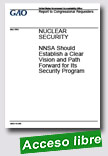 |
Nuclear Security: NNSA Should Establish a Clear Vision and Path Forward for Its Security Program
Government Accountability Office (GAO-US), May 30, 1014, 41 p.
National Nuclear Security Administration (NNSA), a semiautonomous agency in DOE, is responsible for protecting sensitive assets, including classified information and plutonium used at its contractor-operated sites to carry out nuclear weapons-related missions. Contractors provide security at NNSA's sites under the direction and oversight of
|
DNS, NNSA field offices, and DOE. In response to rising security costs and other concerns, from 2009 to 2012, DOE and NNSA initiated various reforms to identify and eliminate potentially unnecessary security costs; realign security requirements that may be impeding sites' productivity; and streamline federal oversight. After a serious security breach at its Y-12 site in July 2012, however, NNSA reexamined some of its reforms and considered additional actions.
GAO was asked to examine NNSA's security reforms. GAO examined (1) DOE, NNSA, and contractors' implementation of the 2009 to 2012 security reforms, including any benefits or drawbacks they identified for NNSA and its sites, and (2) NNSA's actions or plans to improve security performance and oversight after the Y-12 security breach. GAO reviewed DOE and NNSA documents and interviewed DOE and NNSA headquarters officials and NNSA field office officials and contractors at the seven NNSA sites.
GAO recommends NNSA develop a clear vision and path forward for its security program and an implementation strategy including regular monitoring. NNSA agreed with the recommendation.
Extraído de: http://www.gao.gov/products/GAO-14-208
|
 |
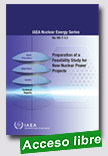 |
Preparation of a Feasibility Study for New Nuclear Power Projects
IAEA Nuclear Energy Series, 2014, 125 p.
A feasibility study represents an important step in the development of a new build nuclear power plant project. It is a complex but necessary step to determine whether a business opportunity is possible, practical and viable. Technical, economical, financial, regulatory, social, environmental aspects of a nuclear power plant programme need to be considered to allow authorities to make informed decisions |
regarding the possible implementation of the project This publication assists Member States in developing a feasibility study for nuclear power projects and provides guidance to users who are planning to perform such a study, with consideration of both the technical and process areas. These guidelines condense the experience of individuals involved in previous feasibility study efforts and provide industry best practices in order to maximize the usefulness of any results.
Extraído de: http://www-pub.iaea.org/books/IAEABooks/10505/Preparation-of-a-Feasibility-Study-for-New-Nuclear-Power-Projects
|
 |
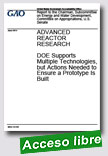 |
Advanced Reactor Research: DOE Supports Multiple Technologies, but Actions Needed to Ensure a Prototype Is Built
Government Accountability Office (GAO-US), June 23, 1014, 52 p.
Department of Energy's (DOE) Office of Nuclear Energy's (NE) conducts R&D on advanced nuclear reactor technologies with multiple aims, including (1) improving the economic competitiveness of nuclear technology to ensure that nuclear power continues to play a role in meeting our nation's energy |
needs; (2) increasing safety; (3) minimizing the risk of nuclear proliferation and terrorism; and (4) addressing environmental challenges, such as reducing greenhouse gas emissions. External groups have been critical of NE for, among other things, how it prioritizes advanced reactor R&D.
GAO was asked to review NE's advanced reactor R&D efforts. This report (1) describes NE's approach to advanced nuclear reactor R&D and (2) examines how NE plans and prioritizes its advanced reactor R&D activities, including deploying an advanced reactor. GAO reviewed laws and reports concerning NE's efforts to develop advanced reactor technologies and interviewed NE officials and a nonprobability sample of companies developing such technology, selected because of their involvement with DOE's R&D efforts.
To better prepare DOE to meet the requirement of EPAct 2005 to deploy the NGNP prototype reactor, GAO recommends that DOE develop a strategy for resuming the NGNP Project and provide a report to Congress updating the status of the project. DOE agreed in principle with GAO's first recommendation and respectfully disagreed with the second. GAO believes these recommendations remain valid as discussed in the report.
Highligths | Report
Extraído de: http://www.gao.gov/products/GAO-14-545 |
 |
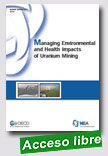 |
Uranium mining and milling has evolved significantly over the years. By comparing currently leading approaches with outdated practices, this report demonstrates how uranium mining can be conducted in a way that protects workers, the public and the environment. Innovative, modern mining practices combined with strictly enforced regulatory standards are geared towards avoiding past mistakes committed |
primarily during the early history of the industry when maximising uranium production was the principal operating consideration. Today?s leading practices in uranium mining aim at producing uranium in an efficient and safe manner that limits environmental impacts to acceptable standards. As indicated in this report, the collection of baseline environmental data, environmental monitoring and public consultation throughout the life cycle of the mine enables verification that the facility is operating as planned, provides early warning of any potentially adverse impacts on the environment and keeps stakeholders informed of developments. Leading practice also supports planning for mine closure before mine production is licensed to ensure that the mining lease area is returned to an environmentally acceptable condition. The report highlights the importance of mine workers being properly trained and well equipped, as well as that of ensuring that their work environment is well ventilated so as to curtail exposure to radiation and hazardous materials and thereby minimise health impacts.
Extraído de:
http://www.oecd-nea.org/tools/publication?query=&div=&lang=&period=6m&sort=
title&filter=1#p7062
|
 |
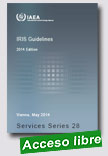 |
IRIS Guidelines 2014 Edition
IAEA Services Series, May 2014, 46 p.
Establishing the safety infrastructure for a nuclear power programme is a continuous process involving several organizations, the number and the role of which evolves as the nuclear programme develops. In the early phases of the programme, some of these organizations may even not exist: this might be the case for the operating organization or the regulatory body.
Coordination mechanisms need to be implemented to reach
|
overall safety objectives and to provide a coherent framework for the evolution and development of each organization. Therefore, self-assessment against SSG-16 should involve every organization that should implement actions listed in the Safety Guide. Coordination mechanisms and responsibilities should be formally defined, including for the management of the whole self-assessment project, to ensure that overall coherence is achieved. The practical form taken by these
mechanisms and definition of responsibilities depend on the phase of the programme.
Extraído de:
http://www-pub.iaea.org/MTCD/Publications/PDF/SVS-28_web.pdf
|
 |
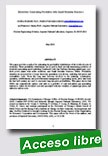 |
Electricity Generating Portfolios with Small Modular Reactors
Office of Nuclear Energy, DOE-NE, May 2014, 47 p.
This paper provides a method for estimating the probability distributions of the levelized costs of electricity. These probability distributions can be used to find cost-risk minimizing portfolios of electricity generating assets including Combined-Cycle Gas Turbines (burning natural gas), coal-fired power plants with sulfur scrubbers, and Small Modular Reactors, SMRs. Probability densities are proposed for a
|
dozen electricity generation cost drivers, including fuel prices and externalities costs. Given the long time horizons involved in the planning, construction, operation, refurbishment, and post-retirement management of generating assets, price data from the last half century are used to represent long-run price probabilities. This paper shows that SMRs can competitively replace coal units in a portfolio of coal and natural gas generating stations to reduce the levelized cost risk associated with the volatility of natural gas prices and unknown carbon costs.
Extraído de http://www.energy.gov/sites/prod/files/2014/06/f16/Electricity%
20Generating%20Portfolios%20with%20SMRs.pdf
|
 |
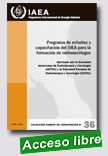
|
Programa de estudios y capacitación del OIEA para la formación de radiooncólogos - Aprobado por la Sociedad Americana de Radioterapia y Oncología (ASTRO) y la Sociedad Europea de Radioterapia y Oncología (ESTRO)
OIEA, 2014, 42 P.
Durante muchos años, el Organismo Internacional de Energía Atómica (OIEA) ha prestado asistencia a sus Estados Miembros en el establecimiento, la explotación y la mejora de las instalaciones de radiooncología. El desarrollo de recursos humanos, que incluye la capacitación de radiooncólogos, físicos médicos, técnicos en radioterapia y enfermeras de |
radiooncología, forma parte de esa asistencia, dado que la falta de profesionales capacitados en esas esferas plantearía un grave obstáculo al acceso de los pacientes de cáncer a la radioterapia.
Para asegurar la uniformidad y la coherencia de la capacitación que podrían proporcionar las diversas instituciones médicas que imparten programas de posgrado en radiooncología, el propósito del OIEA al formular un programa de estudios para la formación y la capacitación de radiooncólogos es proporcionar orientaciones a todos los profesionales y administradores que participan en las actividades de capacitación de esta disciplina. El programa de estudios trata de atender los requisitos de capacitación de los países en desarrollo con el fin de
establecer un marco común y coherente. Proporciona a la vez una estructura para la organización de la capacitación y un plan de estudios básico. Los Estados Miembros pueden adaptar las directrices expuestas en el plan de estudios básico a modo de referencia para un plan de estudios nacional.
Extraído de: http://www-pub.iaea.org/MTCD/Publications/PDF/TCS36_S_web.pdf
|
 |
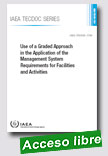 |
Use of a Graded Approach in the Application of the Management System Requirements for Facilities and Activities
IAEA TECDOC, 2014, 104 p.
The objective of this publication is to provide practical guidance to assist users of IAEA Safety Requirements No. GS-R-3: The Management System for Facilities and Activities to develop and apply a grading method appropriate to the risks, complexity and significance of activities of an organization.
This publication is not intended to prescribe an approach to |
grading of the application of management system requirements, but provides guidance based on practical examples of grading that are currently used in IAEA Member States.
Extraído de: http://www-pub.iaea.org/MTCD/Publications/PDF/TE-1740_web.pdf
|
 |
 |
Managing Organizational Change in Nuclear Organizations
IAEA Nuclear Energy Series, 2014, 63 p.
It is widely recognized that engineering changes, if not properly considered and controlled, can have potentially major safety implications; however, organizational changes can also have potentially major safety implications. This publication is intended to assist the management of nuclear organizations in identifying, planning and implementing organizational change. The driving force for the change may be internal or external. Based on the assumption that any change made within a
|
facility applying nuclear technology has the potential to impact safety and effectiveness, the publication provides a description of the basic principles for managing and implementing the organizational change effectively while remaining focused on safe and reliable operation. The guidance contained in the publication is relevant to all organizational changes within nuclear organizations.
Extraído de:
http://www-pub.iaea.org/books/IAEABooks/10394/Managing-Organizational-Change-in-Nuclear-Organizations
|
| |
|
|
|
| |
| |
| |
|
|
| |
| |
|
|
| |
|
|
|
| |
|
|
|
| |
|
|
|
|
|
